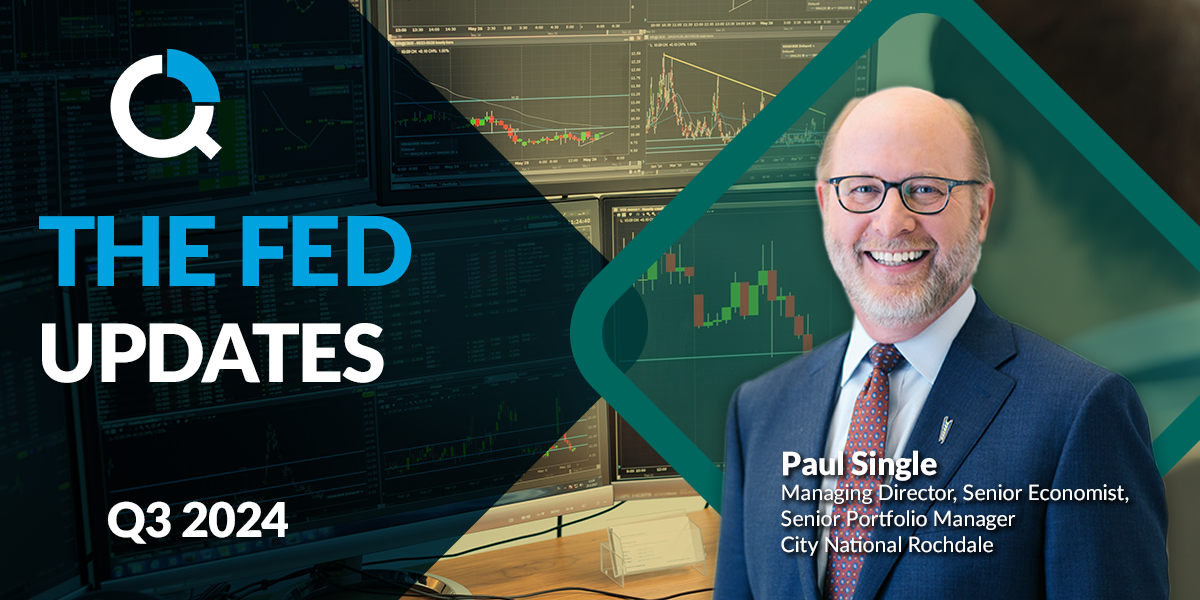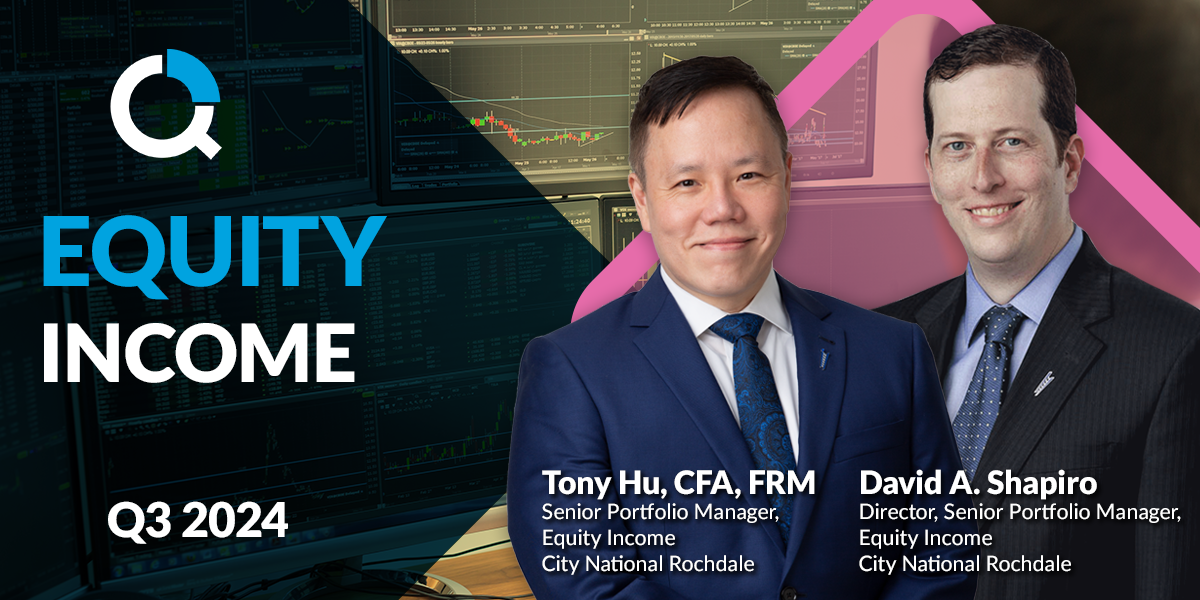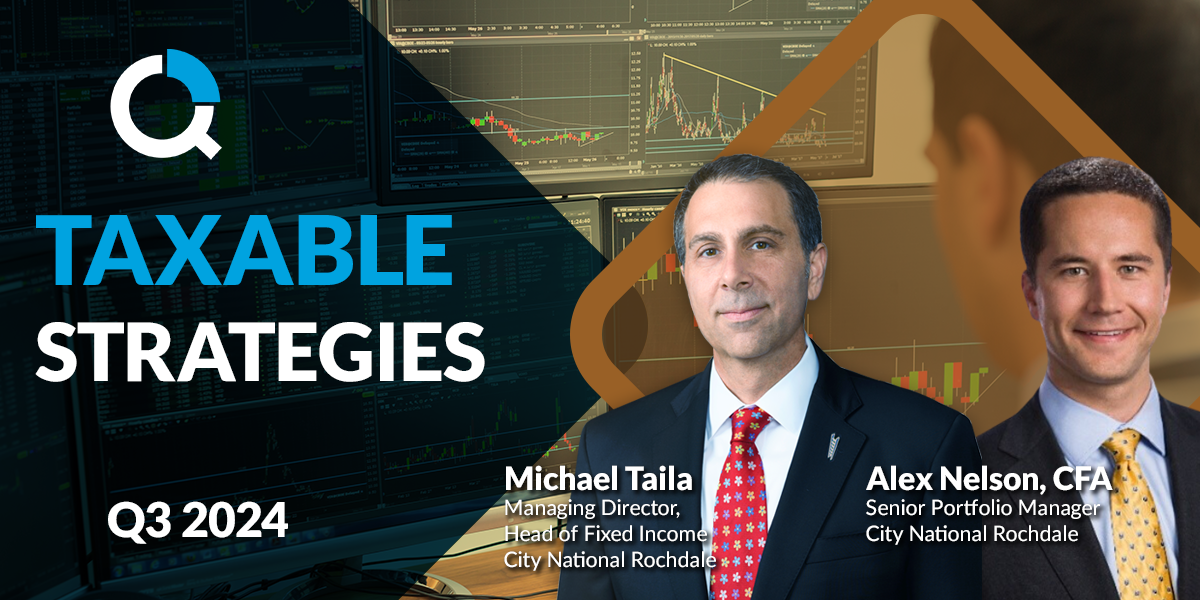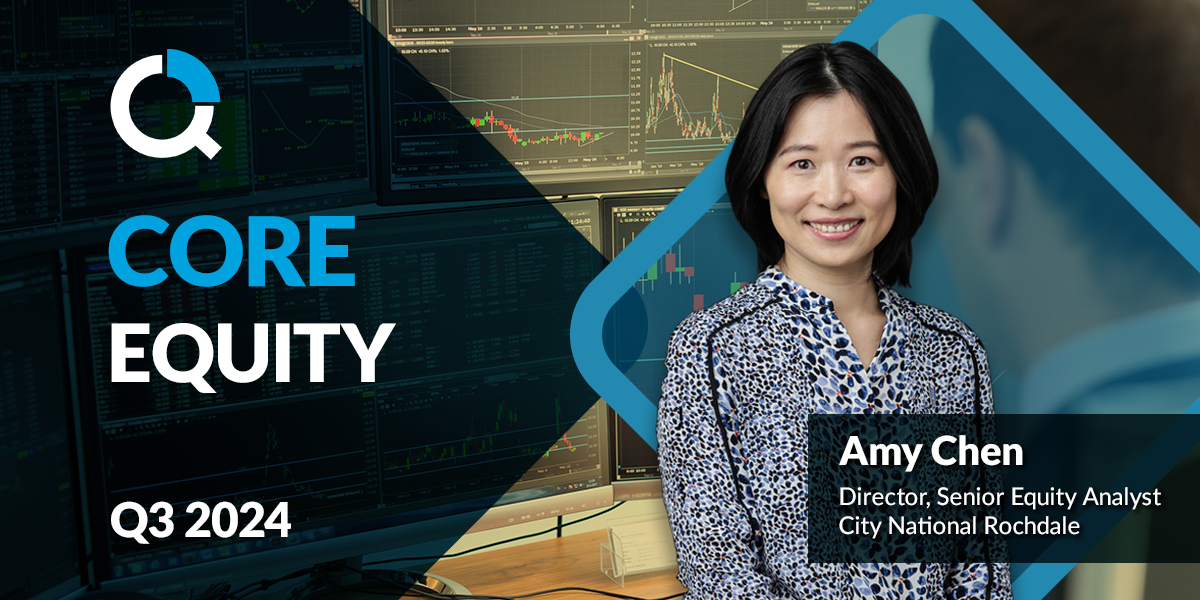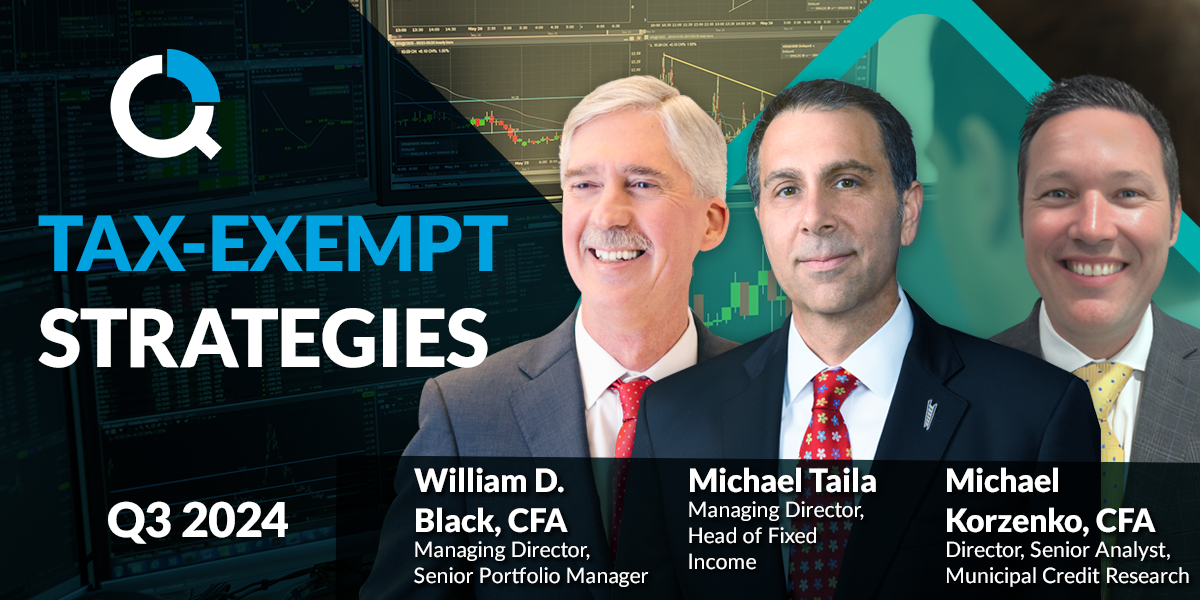
Market Update: Bending, Not Breaking
As the current expansion enters its fifth year, the US economy is clearly downshifting. Economic growth over the first half of 2024 averaged 2.1%, roughly a percentage point lower than the pace recorded in the second half of 2023. Companies are hiring fewer workers and consumers are exercising more caution as high interest rates put pressure on spending. While those dynamics might seem worrying on paper, the current trajectory suggests a normalization to a slower but more sustainable rate of growth is occurring, as opposed to the beginning phases of a recession.
At the midpoint of the year, equity markets are experiencing an uptick in volatility and a shift in market leadership. Value and cyclical parts of the market, including small- and mid-cap stocks, have rallied over the past month, while growth stocks, especially the mega-cap tech names responsible for the lion’s share of market gains over the first half of the year, have lagged. There have been many factors at play behind this rotation, ranging from a broadening in earnings growth and better relative valuations outside of tech to expectations of U.S. election–driven policy shifts.
Chart 1: 2024 Market Performance
Before & After May CPI Data Release on 6/12/24
Source: Bloomberg, as of July 2024.
Past performance is no guarantee of future results.
Above all, it has been a series of better-than-expected inflation readings that have assured investors that Fed rate cuts are around the corner. Entering 2024, it was not clear that the Fed would risk cutting rates as signs of an overheating economy and stubborn inflation were evident. But these issues now appear to be solved. Measures of labor market tightness have fallen sharply and are now only slightly above pre-pandemic levels, on average. Meanwhile, since peaking at a 40-year high of 6.6% two years ago, the three-month annualized rate of change in core CPI inflation has slowed to just 2.1% – the lowest level since March 2021 and not far from the Fed’s 2% target.
Chart 2: Core CPI Inflation
Source: St. Louis Fed, as of June 2024.
Past performance is no guarantee of future results.
Chart 3: Jobs Available Per Unemployed Worker
Source: St. Louis Fed, as of June 2024.
Past performance is no guarantee of future results.
After the upheaval of the past few years, the most aggressive Fed tightening cycle in decades seems to be having the intended effect by bringing supply and demand into better balance. Evidence continues to build for a soft landing, and parts of the economy will continue to struggle against higher rates, including manufacturing, housing and lower-income households. But at this point, the economy has survived tighter Federal Reserve policy without any major signs of severe macroeconomic vulnerabilities. Most notably, and so far absent this cycle, is the development of excess leverage that can create over-investment and spark the type of extended credit cycles that have historically presaged recessions.
For the Fed, this means the tradeoffs are shifting. We have revised our expectations for Fed rate cuts, as incoming inflation and labor data now support a case for an initial rate cut in September and possibly another before the end of the year. We continue to believe officials will be content to take it slow, seeking to reduce rates enough to prevent unnecessary weakness in the economy, while trying to avoid reigniting inflation pressures and the need to keep rates high. Still, the bigger backdrop of a Fed rate-cutting cycle is broadly supportive of sustained economic growth and favorable investment conditions.
After such a strong rally in the equity market, value- and income-oriented stocks that have been dormant are springing to life as investors seek investments that have more room for valuation expansion and that could benefit from lower interest rates. One of the keys coming into 2024 was the expansion of the market rally outside of technology, and it is now clear this is happening after Q1 earnings season and projections for Q2 show a broadening resurgence in earnings.
While technology sectors appear to have stretched valuations and could be due for a correction, a combination of defensible earnings streams and long-term AI growth prospects will remain a tailwind for that group. We believe that the development of AI technology and its impact across the economy is a long-term trend that remains in the early phases. That said, we think the market rotation underway reflects what could be a more durable trend in which lagging sectors and segments market play catch-up, fueling additional gains. The rate of technology- and growth-oriented companies is moderating, while profitability among the rest of S&P 500 is forecasted to accelerate in coming quarters.
Chart 4: S&P 500 Consensus Y/Y Earnings Growth
Source:Factset, as of June 31, 2024.
Indices are unmanaged, and one cannot invest directly in an index. Past performance is not a guarantee of future results.
For the moment, we continue to be positioned well for this move with exposure to income-oriented and mid-cap stocks, alongside high-yield credit exposure, which has benefited from higher treasury rates and resilient economic growth. But, as investors continue to reset expectations within a longer-term market advance, more divergence is likely, which should create tactical opportunities. We will be looking for these pivot points in the months ahead to add quality investments to portfolios and to diversify allocations to participate in the broadening of market returns.
Important Information
The views expressed represent the opinions of City National Rochdale, LLC (CNR) which are subject to change and are not intended as a forecast or guarantee of future results. Stated information is provided for informational purposes only, and should not be perceived as personalized investment, financial, legal or tax advice or a recommendation for any security. It is derived from proprietary and non-proprietary sources which have not been independently verified for accuracy or completeness. While CNR believes the information to be accurate and reliable, we do not claim or have responsibility for its completeness, accuracy, or reliability. Statements of future expectations,estimates, projections, and other forward-looking statements are based on available information and management’s view as of the time of these statements. Accordingly, such statements are inherently speculative as they are based on assumptions which may involve known and unknown risks and uncertainties. Actual results, performance or events may differ materially from those expressed or implied in such statements.
Investing involves risk including loss of principal. The market price of a security may move up and down, sometimes rapidly and unpredictably. The securities of mid-cap companies may have greater price volatility and less liquidity than the securities of larger capitalized companies. Larger, more established companies may be unable to attain the high growth rates of successful, smaller companies during periods of economic expansion. Current and future holdings are subject to risk. There is no guarantee the fund will achieve its stated objective.
City National Rochdale, LLC is an SEC-registered investment adviser and wholly-owned subsidiary of City National Bank. Registration as an investment adviser does not imply any level of skill or expertise. City National Bank is a subsidiary of the Royal Bank of Canada. City National Bank provides investment management services through its subadvisory relationship with City National Rochdale. Brokerage services are provided through City National Securities, Inc., a wholly-owned subsidiary of City National Bank and Member FINRA/SIPC.
Index Definitions
S&P 500 Index: The S&P 500 Index, or Standard & Poor’s 500 Index, is a market-capitalization-weighted index of 500 leading publicly traded companies in the US It is not an exact list of the top 500 US companies by market cap because there are other criteria that the index includes.
S&P 500 Growth: The S&P 500 Growth Index is a stock index administered by Standard & Poor’s-Dow Jones Indices. As its name suggests, the purpose of the index is to serve as a proxy for growth companies included in the S&P 500.
S&P 500 Value: The term S&P 500 Pure Value Index refers to a score-weighted index developed by Standard and Poor’s (S&P). The index uses what it calls a “style-attractiveness-weighting scheme” and only consists of stocks within the S&P 500 Index that exhibit strong value characteristics. The index was launched in 2005 and consists of 120 constituents, the majority of which are financial services companies.
S&P 500 Equal Weight: The S&P 500® Equal Weight Index (EWI) is the equal-weight version of the widely-used S&P 500. The index includes the same constituents as the capitalization weighted S&P 500, but each company in the S&P 500 EWI is allocated a fixed weight - or 0.2% of the index total at each quarterly rebalance.
DJDVP: The Dow Jones U.S. Select Dividend Index aims to represent the U.S.’s leading stocks by dividend yield.
Bloomberg Municipal Bond Index: The Bloomberg US Municipal Bond Index measures the performance of investment grade, US dollar-denominated, long-term tax-exempt bonds.
Bloomberg Municipal High Yield Bond Index: The Bloomberg Municipal High Yield Bond Index measures the performance of non-investment grade, US dollar-denominated, and non-rated, tax-exempt bonds.
Bloomberg Investment Grade Index: The Bloomberg US Investment Grade Corporate Bond Index measures the performance of investment grade, corporate, fixed-rate bonds with maturities of one year or more.
The Nasdaq Composite Index is a market capitalization-weighted index of more than 2,500 stocks listed on the Nasdaq stock exchange.
The Russell 2000 Index is a stock market index that measures the performance of the 2,000 smaller companies included in the Russell 3000 Index.
The Bloomberg Magnificent 7 Total Return Index is an equal-dollar weighted equity benchmark consisting of a fixed basket of 7 widely-traded companies classified in the United States and representing the Communications, Consumer Discretionary and Technology sectors as defined by Bloomberg Industry Classification System (BICS).
Definitions
Yield to Worst (YTW) is the lower of the yield to maturity or the yield to call. It is essentially the lowest potential rate of return for a bond, excluding delinquency or default.
P/E Ratio: The price-to-earnings ratio (P/E ratio) is the ratio for valuing a company that measures its current share price relative to its earnings per share (EPS).
The 4P analysis is a proprietary framework for global equity allocation. Country rankings are derived from a subjective metrics system that combines the economic data for such countries with other factors including fiscal policies, demographics, innovative growth and corporate growth. These rankings are subjective and may be derived from data that contain inherent limitations. MSCI Emerging Markets Asia Index is a free float-adjusted market capitalization index that is designed to measure equity market performance in the Asian emerging markets.
City National Rochdale Proprietary Quality Ranking formula: 40% Dupont Quality (return on equity adjusted by debt levels), 15% Earnings Stability (volatility of earnings), 15% Revenue Stability (volatility of revenue), 15% Cash Earnings Quality (cash flow vs. net income of company) 15% Balance Sheet Quality (fundamental strength of balance sheet).
*Source: City National Rochdale proprietary ranking system utilizing MSCI and FactSet data. **Rank is a percentile ranking approach whereby 100 is the highest possible score and 1 is the lowest. The City National Rochdale Core compares the weighted average holdings of the strategy to the companies in the S&P 500 on a sector basis. As of September 30, 2022. City National Rochdale proprietary ranking system utilizing MSCI and FactSet data.
© 2024 City National Bank. All rights reserved.
Non-deposit investment Products are: • not FDIC insured • not Bank guaranteed • may lose value
Stay Informed.
Get our Insights delivered straight to your inbox.
Read more of this month's Quarterly Update below:
Put our insights to work for you.
If you have a client with more than $1 million in investable assets and want to find out about the benefits of our intelligently personalized portfolio management, speak with an investment consultant near you today.
If you’re a high-net-worth client who's interested in adding an experienced investment manager to your financial team, learn more about working with us here.

